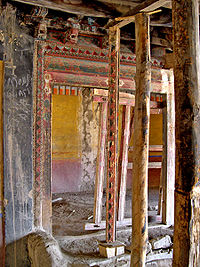
Leh Palace
Encyclopedia
Leh Palace overlooks the Ladakh
i Himalayan town of Leh, modelled on the Potala Palace
in Lhasa
, Tibet
. The palace was built by King Sengge Namgyal
in the 17th century, but was later abandoned when Dogra forces took control of Ladakh in the mid-19th century. The royal family moved to Stok
Palace. Leh Palace is nine storeys high; the upper floors accommodated the royal family, the stables and store rooms were in the lower floors.
The palace, a ruin, is currently being restored by the Archaeological Survey of India
. The palace is open to the public and the roof provides panoramic views of Leh and the surrounding areas. The mountain of Stok Kangri
in the Zangskar mountain range is visible across the Indus valley to the south, with the Ladakh
mountain range rising behind the palace to the north.
The richest collection of jewellery, ornaments, Thangkas and so on is in the Palace Museum. One finds in the museum ceremonial dresses, crowns, and centuries-old pieces of jewellery. There are Chinese Thangka
or sooth paintings which are more than 450 years old. They still look new. The bright and pleasing colours and the intricate designs are breathtaking. The colours are said to have been derived from crushing and powdering gems and stones.
Ladakh
Ladakh is a region of Jammu and Kashmir, the northernmost state of the Republic of India. It lies between the Kunlun mountain range in the north and the main Great Himalayas to the south, inhabited by people of Indo-Aryan and Tibetan descent...
i Himalayan town of Leh, modelled on the Potala Palace
Potala Palace
The Potala Palace is located in Lhasa, Tibet Autonomous Region, China. It was named after Mount Potala, the abode of Chenresig or Avalokitesvara...
in Lhasa
Lhasa
Lhasa is the administrative capital of the Tibet Autonomous Region in the People's Republic of China and the second most populous city on the Tibetan Plateau, after Xining. At an altitude of , Lhasa is one of the highest cities in the world...
, Tibet
Tibet
Tibet is a plateau region in Asia, north-east of the Himalayas. It is the traditional homeland of the Tibetan people as well as some other ethnic groups such as Monpas, Qiang, and Lhobas, and is now also inhabited by considerable numbers of Han and Hui people...
. The palace was built by King Sengge Namgyal
Sengge Namgyal
Sengge Namygal was a 17th century Namgyal dynasty King of Ladakh, India from 1616 to his death in 1642. A Buddhist, he was noted for his immense work in building monasteries, palaces and shrines in Ladakh and is known as the "Lion King"....
in the 17th century, but was later abandoned when Dogra forces took control of Ladakh in the mid-19th century. The royal family moved to Stok
Stok
Stok or Stak, museum and gompa in village of the same name, situated in the Indus Valley 17 km south east of the Ladakhi capital, Leh. Stok is the current residence of the former royal family of Ladakh and the museum contains the shrines, crown, ceremonial dress and jewelry of the Ladakhi...
Palace. Leh Palace is nine storeys high; the upper floors accommodated the royal family, the stables and store rooms were in the lower floors.
The palace, a ruin, is currently being restored by the Archaeological Survey of India
Archaeological Survey of India
The Archaeological Survey of India is a department of the Government of India, attached to the Ministry of Culture . The ASI is responsible for archaeological studies and the preservation of archaeological heritage of the country in accordance with the various acts of the Indian Parliament...
. The palace is open to the public and the roof provides panoramic views of Leh and the surrounding areas. The mountain of Stok Kangri
Stok Kangri
Stok Kangri Stok Kangri Stok Kangri (elevation 6,153 m (20,182 feet) is the highest mountain in the Stok Range of the Himalayas in the Ladakh region of northwest India. The peak is located in Hemis National Park, 12 km southwest of the trailhead at 3,610 m (11,845 feet) in the village of Stok...
in the Zangskar mountain range is visible across the Indus valley to the south, with the Ladakh
Ladakh
Ladakh is a region of Jammu and Kashmir, the northernmost state of the Republic of India. It lies between the Kunlun mountain range in the north and the main Great Himalayas to the south, inhabited by people of Indo-Aryan and Tibetan descent...
mountain range rising behind the palace to the north.
 |
 |
The richest collection of jewellery, ornaments, Thangkas and so on is in the Palace Museum. One finds in the museum ceremonial dresses, crowns, and centuries-old pieces of jewellery. There are Chinese Thangka
Thangka
A "Thangka," also known as "Tangka", "Thanka" or "Tanka" is a Tibetan silk painting with embroidery, usually depicting a Buddhist deity, famous scene, or mandala of some sort. The thankga is not a flat creation like an oil painting or acrylic painting...
or sooth paintings which are more than 450 years old. They still look new. The bright and pleasing colours and the intricate designs are breathtaking. The colours are said to have been derived from crushing and powdering gems and stones.

